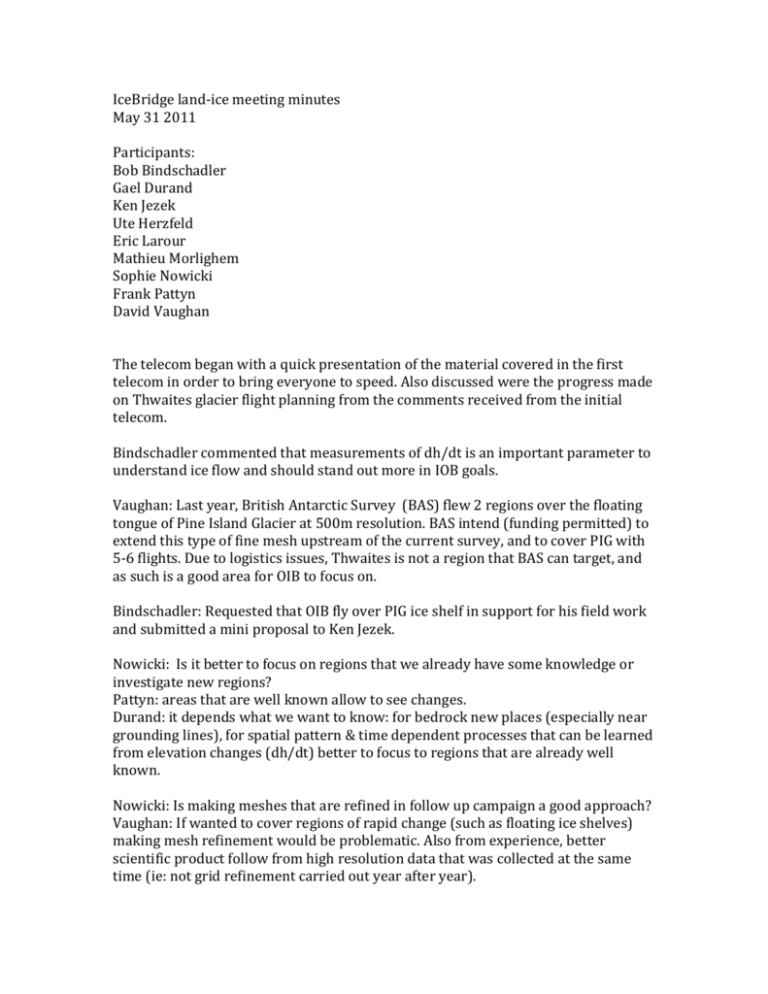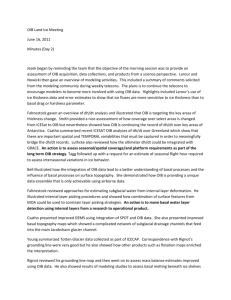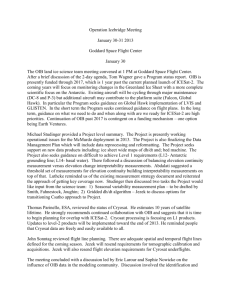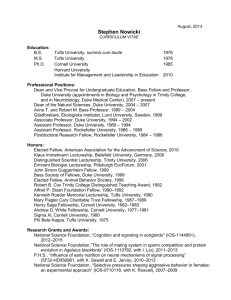IceBridgeIOB31may
advertisement

IceBridge land-ice meeting minutes May 31 2011 Participants: Bob Bindschadler Gael Durand Ken Jezek Ute Herzfeld Eric Larour Mathieu Morlighem Sophie Nowicki Frank Pattyn David Vaughan The telecom began with a quick presentation of the material covered in the first telecom in order to bring everyone to speed. Also discussed were the progress made on Thwaites glacier flight planning from the comments received from the initial telecom. Bindschadler commented that measurements of dh/dt is an important parameter to understand ice flow and should stand out more in IOB goals. Vaughan: Last year, British Antarctic Survey (BAS) flew 2 regions over the floating tongue of Pine Island Glacier at 500m resolution. BAS intend (funding permitted) to extend this type of fine mesh upstream of the current survey, and to cover PIG with 5-6 flights. Due to logistics issues, Thwaites is not a region that BAS can target, and as such is a good area for OIB to focus on. Bindschadler: Requested that OIB fly over PIG ice shelf in support for his field work and submitted a mini proposal to Ken Jezek. Nowicki: Is it better to focus on regions that we already have some knowledge or investigate new regions? Pattyn: areas that are well known allow to see changes. Durand: it depends what we want to know: for bedrock new places (especially near grounding lines), for spatial pattern & time dependent processes that can be learned from elevation changes (dh/dt) better to focus to regions that are already well known. Nowicki: Is making meshes that are refined in follow up campaign a good approach? Vaughan: If wanted to cover regions of rapid change (such as floating ice shelves) making mesh refinement would be problematic. Also from experience, better scientific product follow from high resolution data that was collected at the same time (ie: not grid refinement carried out year after year). Vaughan: There is a number of data which is available as lat-long-pixel value available from BAS upon request. However, Bedmap2 which will be presented at fall AGU 2011 will always be presented as a gridded product. Durand: Bedrock information on lat-lon points are extremely important, but not so much the thickness because of potential inconsistency in data collection efforts can results in inconsistent bedrock. Questions that remain unanswered: Larour: Are there regions where we know that our models do not work? Jezek: What are the key processes that we do not understand that could be answered with new data collection? Nowicki: Is it better to fly grids, flow lines, lines along flux gates? Pattyn: Grid flight lines are useful for models, but so are flow lines along the main trunk as they can easily be turned to model experiments of dh/dt. Vaughan: From experience, it is extremely difficult to plan flow line (ie determine the flow line with precision) in regions of slow flow, unless a very dense group of flow lines is flown. Flux gate are more convenient. Durand: Flow lines are important in regions where the grounding line might retreat to. Morlighem: The problem with flow lines is that they do not constrain the flux in a basin, but flux gate allow constraining the data and therefore might be more useful. Pattyn: To get around the difficulty in planning flow lines in slow ice regions: carry out flow lines across the grounding line combined with cross flow measurement further inland. Returning to the data collected over PIG during previous OIB campains (fine grid near grounding line and arch/flux gate over Icesat tracks): group consensus that it is a useful pattern to repeat for different regions. Pattyn: carry out repeat surveys of the PIG arch for dh/dt, but as Larour commented we need to identify a dh/dt that we require from a modeling perspective in order to indentify the optimal time to refly these tracks. The next telecom is scheduled for Tuesday 7th June at 8am Pacific, 11am Eastern, and 15:OO GMT. Details will follow. There are also plans to have a meeting during next week’s IGS meeting, date and time to be confirmed.











